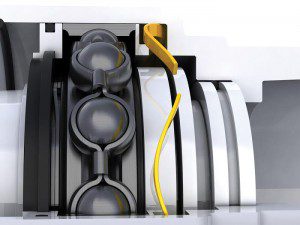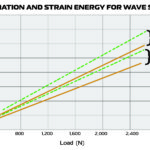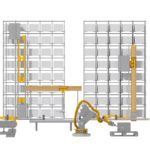
Updated November 2018 by Lisa Eitel || A wave spring is a compression spring made of coiled flat wire with waves added along the coils to give it a spring effect. They can be used in place of conventional round-wire springs in applications that need tight load deflection.
Summary of wave-spring types
There are almost as many variations of wave springs as there are spring applications. Although often out of sight, these springs are essential in many motion-control applications—including gear assemblies, actuators, rotary unions, and different kinds of clutches—and consumer applications as well.
There are three types of springs—tension, compression, and torsion.
• Tension springs operate in tension with a load attached, so as the application applies load this spring stretches out. Compression springs, as the name implies, operate under compression, so as the application applies load, this spring becomes shorter. Torsion springs operate under twisting loads, which means the application applies torque to the spring.
• Compression springs are the most common wave-spring type. Manufacturers make these out of coiled flat wire with waves added along the coils for more spring effect. Such wave springs can replace conventional round-wire compression springs in applications that have minimal space but need tight load deflection.
• As an alternative to other coil springs, wave springs occupy 30 to 50% of the compressed height space of comparable round-wire springs with the same deflection and load specifications. Manufacturers typically make wave springs from a single filament of flat wire formed in continuous precise coils with uniform diameters and waves … most commonly out of 17-7pH hardened stainless steel. Manufacturers make the springs with either plain ends (for wavy) or squared-flat ends (with shim ends).
Read the related article: How to Size and Select a Wave Spring
Wave springs operate as load bearing devices. They take up play and compensate for dimensional variations within assemblies. They can produce a range of forces whereby loads build either gradually or abruptly to reach a predetermined working height. This establishes a precise spring rate in which load is proportional to deflection.
Other wave-spring variations
Some manufacturers offer single, nested, and multi-turn wave springs. A single-turn wave spring with overlapping ends saves axial space so that more space is given for travel. The spring clings to the bore, which saves more radial space. The overlapping ends prevent radial jamming because a circumferential movement is allowed. The spring ends could move against each other so that the specification load at work height is always given. (More after the jump.)

Nested wave springs suit applications requiring higher forces to meet safety regulations, such as those in government or military applications. A nested-wave spring provides a higher load than a single-turn wave spring — a stamped wave washer — and uses the same radial space as a single-turn design. (More after the video.)
Multiple-turn wave springs do not cling to the bore, because radial jamming affects the specified load at work height. If the design of the multi-turn wave spring results in peripheral movement of the turns against each other, this can render the spring unstable.
Compared to a single-turn design, longer travel or deflection is possible because the deflection in total is split. Every turn must tolerate less deflection than a single-turn design. Use of a multi-turn wave spring can also save 50% in axial space compared to a traditional coil spring. What’s more, these springs eliminate the risk of torsional movements during compression to work height … a real problem with coil springs. In contrast, a wave spring always applies its load in an axial direction. Wave springs also apply very consistent loads within a small tolerance range at different work heights. That lets design engineers easily adjust the application to meet given requirements when needed.







Leave a Reply
You must be logged in to post a comment.